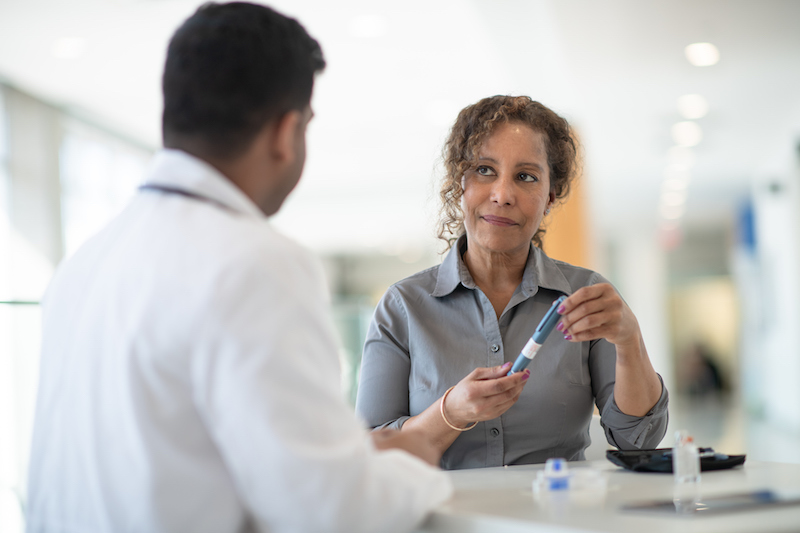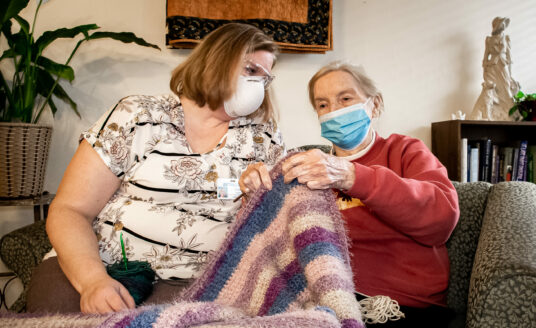You can receive a diabetes diagnosis at any age, but the chances increase as you get older. According to statistics, 26.8 percent of adults 65 and older are living with diabetes.
You may be shocked when you first receive a diabetes diagnosis, but if you learn and practice ways to manage the disease, you can live a full life. This requires a daily lifelong commitment to learning about diabetes and seeking out the many resources and professionals who will help you.
Learn About Diabetes
There are two main types of diabetes: Type 1 and Type 2. Type 1 diabetes is most commonly diagnosed in children, but some seniors may be living with this form of the disease.
In Type 1, the body does not make insulin. Insulin is a hormone that regulates the level of glucose (sugar) in your body that your cells use for energy. Without insulin, the level of glucose in your blood will rise and, over time, cause serious health problems.
In Type 2 diabetes, the body does not make or use insulin well. It is the most common form of diabetes, occurring most often in middle-aged and older adults, but it can also affect children.
Diabetes of either type can affect many parts of your body and lead to the following:
- Heart disease
- Stroke
- Kidney disease
- Blindness
- Gum disease
- Foot ulcers
- Nerve damage that may lead to amputation
Also, people with Type 2 diabetes may be at a greater risk for dementia.
To manage either type of diabetes, you should practice healthy eating, stay physically active, maintain an optimum weight, closely monitor your blood glucose levels, and take your medications as prescribed.
The major exception is that with Type 1, you will need to give yourself insulin shots every day.
With Type 2 diabetes, you may be able to manage the disease through diet and exercise alone — or you may require medications, which potentially could include insulin.
There are tests with which you will become familiar:
A1C test. A test that measures a person’s average blood glucose level over the past two or three months.
Blood glucose level. Measured by a glucometer, this is the amount of blood glucose at a specific time. There are recommended ranges of these glucose levels based upon when you last ate.
Some terms include:
Diabetic ketoacidosis. This is an emergency condition in which high blood glucose levels, along with a lack of insulin, results in the accumulation of ketones in the blood and urine. If left untreated, it can lead to a coma and death.
Glucometer. A small portable machine used to check blood glucose levels. After pricking your skin with a lancet, you place a drop of your blood on a test strip that is inserted into the machine, which will display your glucose level.
Hyperglycemia. High levels of blood glucose. The signs of hyperglycemia may be an early indication that a person has diabetes. They include:
- Increased thirst
- Headaches
- Trouble concentrating
- Blurry vision
- Dizziness
- Constant fatigue
- Unexplained weight loss
- Skin infections
- Cuts and sores that do not heal properly
- Vision deterioration
- Nerve damage
- Erectile dysfunction
- Gastrointestinal problems
- Permanent damage to organs and blood vessels
Hypoglycemia. Low levels of blood glucose. Symptoms often occur when your blood sugar drops below 70 milligrams per deciliter on your glucometer. Symptoms include:
- hunger
- fatigue
- nervousness
- shakiness
- perspiration
- dizziness
- sleeplessness
- confusion
- blurred vision
Left untreated, it may lead to unconsciousness. One treatment option, if the person is conscious, are chewable glucose tablets or consuming carbohydrate-rich foods such as juice.
Neuropathy. A disease of the nervous system. The most common form for people with diabetes is peripheral neuropathy, which affects mainly the legs and feet.
Retinopathy. This is an eye disease caused by damage to the small blood vessels in the retina. Loss of vision may result. (Also known as diabetic retinopathy).
Seek Medical Care and Support
At first, diabetes may seem like an overwhelming array of restrictions, definitions, and conditions. You can’t learn everything at once and not by yourself. There are many professionals to support and help you sort through all the information and questions you may have.
Consult closely with your physician about your care. He or she may recommend seeing an endocrinologist, a physician who specializes in treating the network of hormone-producing glands in the body which includes treating diabetes.
Diabetes management involves a lot of information about diet, exercise, medications, glucose level monitoring, and other components of treatment, as well as symptom recognition. Therefore, it might be wise to consider a diabetes educator, who has an extensive knowledge of diabetes and is certified to coach people with the disease.
Registered dietitians are also well-versed in the dietary requirements of people with diabetes, and can tailor a nutritious meal plan to meet your needs.
Explore How Diabetes Management Technology Has Improved
The more you learn about diabetes, the more you will discover that managing the disease has improved dramatically.
In the 1970s, the home glucose monitor came along. Now, continuous glucose monitoring (CGM) systems track your glucose levels 24/7 with no need for constant needle sticks to sample blood glucose.
The 70s also saw the arrival of the first insulin pumps, which were then bulky backpack contraptions that few people were interested in using.
Today, insulin pumps are about the size of a deck of cards. They are computer-powered devices that can deliver insulin without injections. The pumps provide a continuous flow of insulin in a predetermined amount and thereby improves your ability to manage your blood glucose levels.
The range of medications to control blood glucose levels in type 2 diabetes has expanded, and insulin regimens can now be adjusted very precisely to the individual patient with Type 1 or Type 2 diabetes.
Mental and Emotional Management
Managing diabetes is a continuous learning process. How it reacts in your body may change over time or even day-to-day. It can be frustrating when you don’t achieve the results that you believe you should have, and you may resent having to go through the management process. It is not uncommon for people with diabetes to feel emotionally drained, completely overwhelmed, and depressed.
As you manage your diabetes, you should reach out to those around you to talk honestly and openly about what you are experiencing. Mental health care providers can also provide guidance and support.
Find more articles about diabetes and senior health on Bethesda’s blog.
| Whether in independent living, assisted living, memory care, or skilled nursing, Bethesda offers the right amenities, services, programming, and staff to make every day full of purpose. See for yourself and tour our independent living communities, including Bethesda Barclay House – Clayton, Bethesda Gardens – Kirkwood, Bethesda Orchard – Webster Groves, Bethesda Terrace – South County, Village North Retirement Community – Florissant, and The Oaks at Bethesda Villas – Kirkwood/Webster. |



